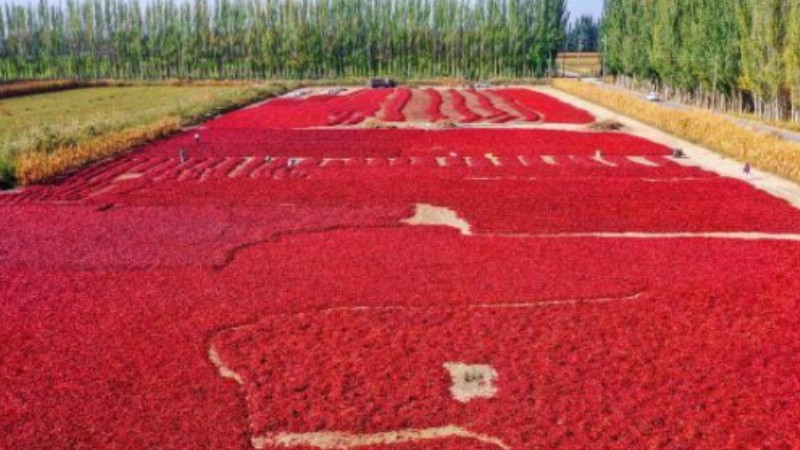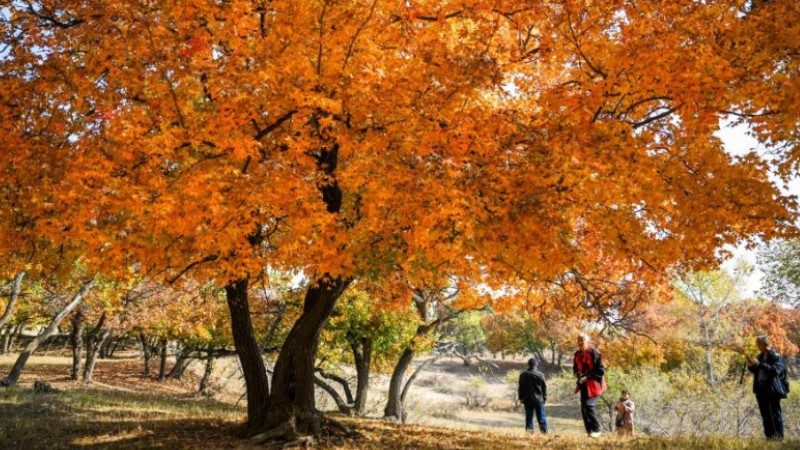Oil-tea camellia brings prosperity to county in C China's Henan
Guangshan county in Xinyang city, central China's Henan Province has blazed a trail to prosperity by taking advantage of its natural environment to develop the oil-tea camellia industry and ecotourism.
Guangshan county is an ideal place for the planting of oil-tea camellia trees, a vital source of edible oil obtained from their seeds for its sound environment and humid climate, with the average year-round temperature of about 15 degrees Celsius. The hilly areas, which account for over half of the county's land and include abundant barren hills, provide conditions for the planting of oil-tea camellia trees.

An aerial view of the Sima Guang Oil-tea Camellia Plantation. (People’s Daily Online/Chang Liyuan)
In June 2009, Guangshan county sent local entrepreneurs to other places to investigate and study the development of the oil-tea camellia industry. They visited oil-tea camellia plantations in east China's Jiangxi Province. Chen Shifa, one of the entrepreneurs, tried to plant oil-tea camellia trees on barren hills in the county’s Huaidian township after the visit.
However, Chen Shifa found that the varieties of oil-tea camellia trees he introduced to the township were not resistant to cold temperatures and had low yields. He revisited Jiangxi and brought back over 2,000 seedlings of more than 20 mainstream varieties of oil-tea camellia trees.
After a trial planting of these seedlings for two years, Chen Shifa selected the best variety and began large-scale planting. He established a demonstration planting base in 2011 and invited Yao Xiaohua, chief expert from the National Center for Oil-Tea Camellia Science to instruct farmers on how to plant oil-tea camellia trees.
Gradually, oil-tea camellia trees on barren hills spanning tens of thousands of mu (one mu equals 0.067 hectares) in the western part of Huaidian township began to bear fruit.
Guangshan county started developing the oil-tea camellia industry to enrich local people in 2011. Six years later, Chen Shifa's demonstration planting base was renamed Sima Guang Oil-Tea Camellia Plantation. At present, the plantation has 33,000 mu of oil-tea camellia trees in Huaidian township. The total area of oil-tea camellia trees in the county reached 292,000 mu.
To increase the added value of oil-tea trees, a production line with an annual output of 8,000 tonnes of tea-seed oil and an investment of over 100 million yuan ($13.7 million) was put into operation at the Lianxing oil-tea industrial park in January 2020.
"We are making efforts to develop the whole industrial chain of the tea-seed oil sector," said Chen Zhu, who is in charge of the oil-tea industrial park. For example, the shells of tea seeds are used as fertilizers, and tea saponin extracted from the pressed cakes of tea seeds is made into daily chemical supplies.
In recent years, the forestry bureau of Guangshan county and Lianxing oil-tea company established a seedling breeding base of oil-tea camellia trees and held over 10 training sessions on camellia grafting technology for more than 800 trainees.
Ao Shuangye, a villager at Zoupeng village in the county, works at the breeding base and can earn over 3,000 yuan per month.
A whole industrial chain of the oil-tea camellia sector, covering seedling breeding, deep processing, e-commerce and logistics, is taking shape in the county.
So far, the county is home to six 10,000-mu oil-tea bases and 50 1,000-mu bases. Over 1,000 college graduates have returned to the county to engage in the whole industrial chain of the oil-tea camellia sector that helps more than 50,000 locals find employment nearby.
Oil-tea camellia plantations in the county have also attracted throngs of tourists. Sima Guang Oil-tea Camellia Plantation now receives over 50,000 tourist visits every year, generating an extra income of more than 5 million yuan through ecotourism.
Photos
Related Stories
- Oil tea industry brings wealth to southwest township
- Chinese vice premier stresses advancing rural revitalization
- New types of farmers inject vitality into rural industries
- Man in Inner Mongolia leads fellow farmers to prosperity through horse-head fiddle manufacturing
- Holiday tourism contributes to China's rural revitalization
- Farmers harvest grapes in SW China's Sichuan
Copyright © 2023 People's Daily Online. All Rights Reserved.









